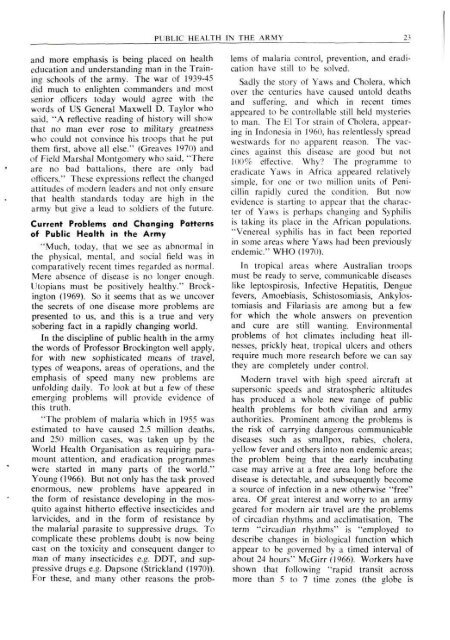ISSUE 3 : Mar/Apr - 1977 - Australian Defence Force Journal
ISSUE 3 : Mar/Apr - 1977 - Australian Defence Force Journal
ISSUE 3 : Mar/Apr - 1977 - Australian Defence Force Journal
You also want an ePaper? Increase the reach of your titles
YUMPU automatically turns print PDFs into web optimized ePapers that Google loves.
PUBLIC HEALTH IN THE ARMY 23and more emphasis is being placed on healtheducation and understanding man in the Trainingschools of the army. The war of 1939-45did much to enlighten commanders and mostsenior officers today would agree with thewords of US General Maxwell D. Taylor whosaid, "A reflective reading of history will showthat no man ever rose to military greatnesswho could not convince his troops that he putthem first, above all else." (Greaves 1970) andof Field <strong>Mar</strong>shal Montgomery who said, "Thereare no bad battalions, there are only badofficers." These expressions reflect the changedattitudes of modern leaders and not only ensurethat health standards today are high in thearmy but give a lead to soldiers of the future.Current Problems and Changing Patternsof Public Health in the Army"Much, today, that we see as abnormal inthe physical, mental, and social field was incomparatively recent times regarded as normal.Mere absence of disease is no longer enough.Utopians must be positively healthy." Brockington(1969). So it seems that as we uncoverthe secrets of one disease more problems arepresented to us, and this is a true and verysobering fact in a rapidly changing world.In the discipline of public health in the armythe words of Professor Brockington well apply,for with new sophisticated means of travel,types of weapons, areas of operations, and theemphasis of speed many new problems areunfolding daily. To look at but a few of theseemerging problems will provide evidence ofthis truth."The problem of malaria which in 1955 wasestimated to have caused 2.5 million deaths,and 250 million cases, was taken up by theWorld Health Organisation as requiring paramountattention, and eradication programmeswere started in many parts of the world."Young (1966). But not only has the task provedenormous, new problems have appeared inthe form of resistance developing in the mosquitoagainst hitherto effective insecticides andlarvicides, and in the form of resistance bythe malarial parasite to suppressive drugs. Tocomplicate these problems doubt is now beingcast on the toxicity and consequent danger toman of many insecticides e.g. DDT, and suppressivedrugs e.g. Dapsone (Strickland (1970)).For these, and many other reasons the problemsof malaria control, prevention, and eradicationhave still to be solved.Sadly the story of Yaws and Cholera, whichover the centuries have caused untold deathsand suffering, and which in recent timesappeared to be controllable still held mysteriesto man. The El Tor strain of Cholera, appearingin Indonesia in 1960, has relentlessly spreadwestwards for no apparent reason. The vaccinesagainst this disease are good but not100% effective. Why? The programme toeradicate Yaws in Africa appeared relativelysimple, for one or two million units of Penicillinrapidly cured the condition. But nowevidence is starting to appear that the characterof Yaws is perhaps changing and Syphilisis taking its place in the African populations."Venereal syphilis has in fact been reportedin some areas where Yaws had been previouslyendemic." WHO (1970).In tropical areas where <strong>Australian</strong> troopsmust be ready to serve, communicable diseaseslike leptospirosis, Infective Hepatitis, Denguefevers, Amoebiasis, Schistosomiasis, Ankylostomiasisand Filariasis are among but a fewfor which the whole answers on preventionand cure are still wanting. Environmentalproblems of hot climates including heat illnesses,prickly heat, tropical ulcers and othersrequire much more research before we can saythey are completely under control.Modern travel with high speed aircraft atsupersonic speeds and stratospheric altitudeshas produced a whole new range of publichealth problems for both civilian and armyauthorities. Prominent among the problems isthe risk of carrying dangerous communicablediseases such as smallpox, rabies, cholera,yellow fever and others into non endemic areas;the problem being that the early incubatingcase may arrive at a free area long before thedisease is detectable, and subsequently becomea source of infection in a new otherwise "free"area. Of great interest and worry to an armygeared for modern air travel are the problemsof circadian rhythms and acclimatisation. Theterm "circadian rhythms" is "employed todescribe changes in biological function whichappear to be governed by a timed interval ofabout 24 hours" McGirr (1966). Workers haveshown that following "rapid transit acrossmore than 5 to 7 time zones (the clobe is
















